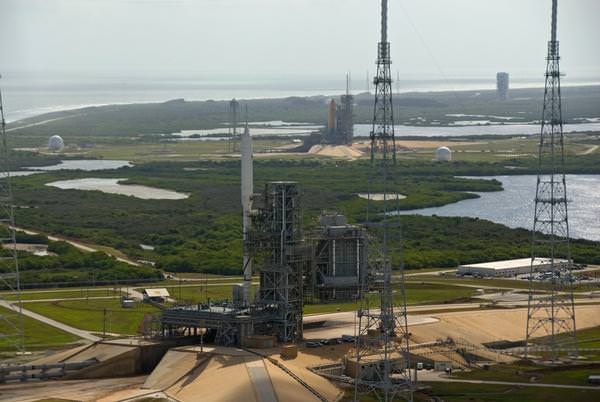[/caption]
The Ares I-X and the space shuttle on the launchpads at KSC. Credit: NASA. Click for larger version.
Possible rain and high clouds are the only “ifs” so far for the test flight of the Ares I-X rocket on Tuesday morning, the first test flight of a new rocket for NASA in over 30 years. Central to the concern about weather is a possible static discharge called “tribo electrification” created by the outer coating of the rocket if it flies through cloud vapor or precipitation that is colder than -10 degrees C (14 deg. F). This static electricity could disrupt the transmission of flight test data from the rocket, one of the main reasons for the test. At a briefing Monday morning, managers for the Ares program said the only other issue they are working with also deals with weather – the timing when to remove a probe cover.
“There are no issues we are currently working,” said Bob Ess, Ares I-X mission manager. “We’ve worked through all the technical issues and it is relatively unprecedented to have a vehicle this clean for this long. Right now we’re just making sure test team is ready. The probe cover is not a new problem; we want to be smart and protect ourselves for when we take it off, because once you take it off you can’t put it on.”
The probe is covered by a “sock” that is Velcroed over the cover. The cover has to be removed manually by pulling a lanyard attached to the cover. If the cover is taken off and it starts to rain, water could get inside, freeze and cause problems with the probe. This doesn’t cause any issues of the vehicle being able to fly, but could cause issues with taking and receiving data.
The probe is part of over 700 sensors for the flight.
The launch window opens at 8 am EDT (1200 GMT), but managers said they can use the entire four-hour window if necessary. $445 million test flight will last six minutes from liftoff to splashdown, with the Ares I-X reaching a maximum altitude of 46,000 m (153,000 feet) and a top velocity more than 4.7 times the speed of sound.
NASA weather officer Kathy Winters said there is a chance of isolated showers, not widespread, but clouds could be a problem. Currently Winters reports a 40% chance of favorable weather for Tuesday. If a 24 hour delay is called, the weather improves to 60% chance of good weather on Wednesday and 70% on Thursday.
“This is a test flight, and not human flight, so there’s not the level of redundancy and the amount analysis if it was,” said Ess. “There are no guarantees, but we have high confidence in the vehicle. We know we’ll learn a lot from this.”
Ess said the main data they will be looking for is that the stage separation occurs at the altitude and speeds that are expected from computer models. “We’ll be receiving data during the flight,” Ess said, “and we’ll get a data recorder back when we recover the booster. We’ll get a huge amount of data from the recorders and compare it with ground station tracking. We’ll merge two different data sets, to get the ‘best of source,’ as its called — get the cleanest , data we can get. That takes a couple of weeks. We have scheduled to give 30-, 60- and 90-day reports, and will be looking through sensor data for any surprises. We have computer models what we expect to see.”
Top of their list of things to look for are information about thrust oscillation issues which have been reported to be a potential show stopper for the Ares program, as well as monitoring acoustics and other pressure sensors. “It will be a long process to go through the large amount of data we’ll be getting” Ess said.
Over 200 sensors will measure how vehicle will bend and stretch throught the various parts fo the flight. They are also interested in seeing how robust the parachute deployement sequence is. A large amount of that data will be gathered through imagery by a chase plane.
When asked about the possibility of this being the only flight for Ares – since the Augustine Commission Report seems to hint at a possible future without the Ares 1 vehicle, Constellation program manager Jeff Hanley said, “What is most critical is that we learn something, and what does it mean for generations coming up. Key for future of human spaceflight is to have tools that allow us to go places we’ve never gone before, and we need substantial tools in our tool kit… What you see in Ares I-X is a stepping stone along the way. With any other architecture we’d be following a similar approach. Whatever the nation asks us to do, the Ares I-X demonstrates a lot of learning.”
Source: NASA press briefing


“What is most critical is that we learn something…” For $445,000,000, I would hope for something more definitive. This whole new “mission” is vague, poor use of few resources, and is without imagination, inspiration, or frankly, purpose.
Even if everything goes well….what will we have done? Lamely reproduced what we did over 40 years before — yawn.
How about a defined mission with specific goals, and that has potential value? We’re going to retire the space shuttle, and replace it with an Apollo wannabe….I shake my head and think there is no part of the American spirit left.
$445 million?
DAAAAMN! Man that is huge dough. If congress cancel this puppy, I will literally rend my clothes in twain, don some sackcloth and go into mourning for all of the astronomy that could have been achieved for that sum of money.